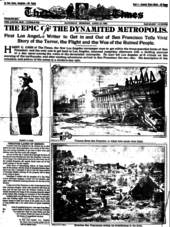Harry Carr
Carr's first newspaper job was in 1897 when he was hired by the Los Angeles Herald on the recommendation of business manager Fred Alles to do "unusual little stories, funny or with heart interest.".
[1] As a young reporter on the hunt for a story, Carr was ejected from a Los Angeles theater when, uninvited, he tried to watch the rehearsal of a play.
"[4] His coverage, reporting and writing was "one of the greatest stories of modern times, one that is still regarded by newspapermen all over the world as a model for the chronicling of some tremendous and awful event," a colleague, Julian Johnson, recalled thirty years later.
"[7] Shortly after, Carr was assigned as Times correspondent in Washington, D.C., and in 1915 he was in Europe, covering World War I from Berlin and elsewhere.
Directors like D.W. Griffith, Cecil B. DeMille, Mack Sennett, Jesse Lasky and Erich von Stroheim called on him to help humanize their films; he became a "story editor-at-large."
an impresario sitting in the old office of The Times, amid mounds of waste paper and mountains of pictures, making drama out of barelegged boys and girls from all over the world leaping and running in the Coliseum.
[10]Between March 1933 and January 1934, Carr made an around-the-world trip and reported on "the bloody retreat of the Chinese before the Japanese invaders" and likened Japanese-occupied Korea "to a perpetual comic opera on a blood-stained stage, with lovely little girls — and lepers — making up the cast."
of the possibility of another European conflagration breaking out in Czecho-Slovakia's capital, of the gaudy but not too impressive show being presented in Italy, and of a precarious ring of steel which France maintains about Germany.
Carr saw ghost ships in the harbor of Manila, and wrote of them; found the women of Bali going about without shirts and had a beetle fight staged for him.
"[11] For these stories and others written on his trip, Carr was nominated for a Pulitzer Prize by James M. Cain, novelist and Burbank, California, screenwriter.
Carr was given an honorable mention in 1934 by the Pulitzer committee on awards for distinguished service as a foreign or Washington correspondent.
[15][16] After Carr became a successful newspaperman, he and his wife maintained two homes — one at 3202 Lowry Road in Los Angeles (between Griffith Park Boulevard and Hillhurst Avenue)[17] and an "oak-shaded picturesque ten-acre retreat" called Las Manzanitas Ranch on McGroarty Street[18] in suburban Tujunga.
It was there that Carr wrote his will "in his sharp, crisp penmanship, almost like printing," nine days before he was stricken by a heart attack and died on January 10, 1936.
In all people who are simple, natural and frank he sees the good with a magnifying glass, but he is continually laughing up his sleeve at shams.
[20] Carr's funeral at Pierce Brothers Mortuary was attended by more than a thousand people who overflowed three chapels.
Father Francis J. Caffrey of Mission San Juan Bautista delivered the eulogy at the request of the family although Carr was not Catholic.
[21] Among the notables were Admiral Joseph M. Reeves, commander-in-chief of the United States Naval Fleet, Sheriff Eugene Biscailuz, actor Harold Lloyd and director Cecil B. DeMille, but the throng also included "Main-street habitues, hard-bitten fellows from the flop-house district.
"[21] Honorary pallbearers included producers Sid Grauman, Sol Lesser, Joseph Schenck, D.W. Griffith, Irvin Cobb and Mack Sennett, boxing champion Jack Dempsey, Judge Isidore B. Dockweiler, actors Ernst Lubitsch, Eric von Stroheim and Leo Carrillo, car dealer and radio station owner Earle C. Anthony and poet and writer John Steven McGroarty.



